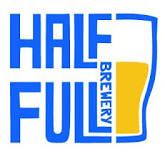

STAMFORD, CONNECTICUT
Plopped into a light industrial complex right off major corridor, Route 95, Stamford’s HALF FULL BREWERY was the brainchild of entrepreneurial zymurgist, Conor Horrigan. Open for business, September ’12, Half Full’s raw white-walled space (with exposed pipes and metal fixtures) offers enough square footage for future expansion.
As I enter through the inconspicuous front door in early January ’13 for a one-hour stopover, the rustic interior where the tasting room resides is completely empty except for a wall-bound brewery insignia, blackboard with flagship beers listed, Tap Map (instructing customers where to get the brewery’s suds), silver stooled tables and two wood community tables.
Down the hall lies the high ceiling brewing space, an unassuming echo-drenched room with silver brew tanks across the temporary serving table. My wife chats with two post-collegiate femmes as I try Half Full’s four fine offerings.
Next to newfound mega-brewery, Two Roads, and decades-old standby, Cottrell’s, this fully-formed operation stands as the third biggest Connecticut brewery.
“We didn’t want to have to scale up immediately,” multi-faceted chief beer organizer Jordan Giles explains. “We have four 40-barrel tanks and room for at least eight more 40-barrels or 60-barrel tanks.”
While Two Roads, twenty miles north, is a multi-million dollar operation with large East Coast distribution, Half Full serves the local community with kegs and growlers to go.
“It’s Conor’s baby,” Giles admits. “He wasn’t happy in his Wall Street job and found it unfulfilling. He wanted to bring people together. After being a home brewer, he worked at New England Brewing for one year with Rob Leonard. Then, he got an MBA and wrote our business plan.”
One of their best clients is Coalhouse Pizza – a beer-centric pizzeria a few miles west. Word is spreading quickly.
As we converse, I settle into the splendidly easygoing sessionable flagship blonde ale, Bright Ale, a pilsner-evoking Vienna-malted moderation with grassy-hopped lemony grapefruit florality and honeyed grain sublimity caressing the soft white-breaded spine.
Next up, simply named fellow flagship, India Pale Ale, utilized dry rye malts to deepen the piney citric profile, earthen peat dewiness and juicy Cascade hop-oiled orange and grapefruit bittering (as well as ancillary pineapple, peach, mango and passion fruit tropicalia).
As a collective, Half Full’s handful of employees all brew. Test batches are made on a half-barrel nanosystem.
“When I heard Conor was interested in brewing, we went for a run and grabbed a brew at (local hotspot) Brennan’s. It’s a famous hole-in-the-wall tavern from the 1800’s. Conor had investment money and just got this space. They were installing tanks when I arrived. We did three months of construction before brewing began,” Giles confides.
A sessionable seasonal from an “unplanned batch” gets poured post-haste. Not far removed from a toasted lager, the one-time InAugur Ale, blends sourdough breaded Vienna malting with grassy-hopped mineral graining and airborne whey-alfalfa-wheatgrass, gaining lemony orange tartness down the stretch.
“All our beers are slightly hybridized. Bright Ale’s a blonde ale hybrid. The IPA’s rye malts taste different than the stylistic standard. We’re doing an amber ale tasting tomorrow to see which recipe is best. Plus, our chocolate coffee brown’s not a stout or porter,” Giles says as he smiles.
Before heading to dinner at nearby SBC, I sample the above-mentioned Chocolate Coffee Brown Ale, a nifty collaboration with a local Darien coffeeshop. Its mild ground coffee roast brings sourness to brown, dark and Baker’s chocolate malting as well as molasses-sapped Brazil nut, hazelnut and walnut illusions (plus dark toffee snips).
“Our work is still not done,” Giles concludes as he fills a few growlers. “The front space will become the main tap space soon. Then, we’ll fill out the back.”